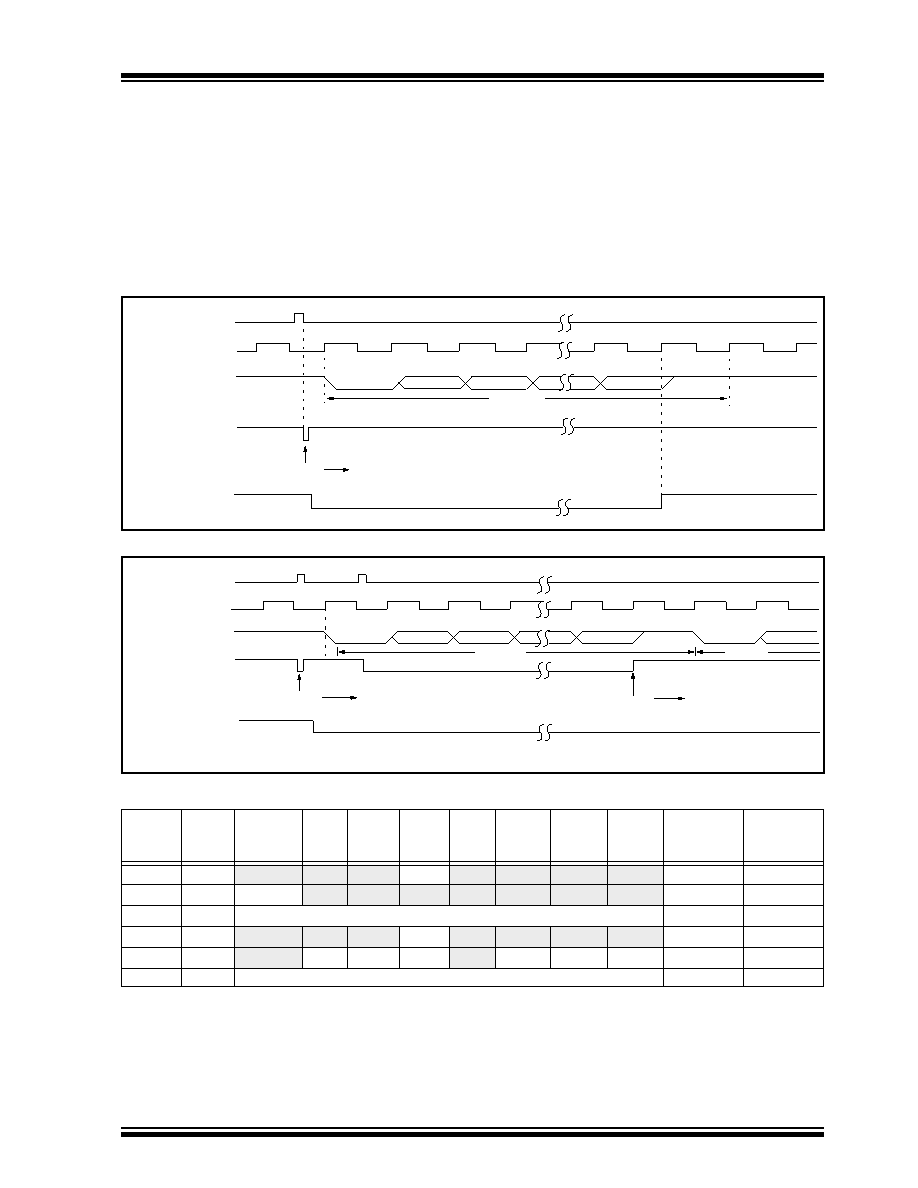- 您现在的位置:买卖IC网 > Sheet目录3818 > PIC16C73A-04/SO (Microchip Technology)IC MCU OTP 4KX14 A/D PWM 28SOIC

1997 Microchip Technology Inc.
DS30390E-page 107
PIC16C7X
Steps to follow when setting up an Asynchronous
Transmission:
1.
Initialize the SPBRG register for the appropriate
baud rate. If a high speed baud rate is desired,
set bit BRGH. (Section 12.1)
2.
Enable the asynchronous serial port by clearing
bit SYNC and setting bit SPEN.
3.
If interrupts are desired, then set enable bit
TXIE.
4.
If 9-bit transmission is desired, then set transmit
bit TX9.
5.
Enable the transmission by setting bit TXEN,
which will also set bit TXIF.
6.
If 9-bit transmission is selected, the ninth bit
should be loaded in bit TX9D.
7.
Load data to the TXREG register (starts trans-
mission).
FIGURE 12-8: ASYNCHRONOUS MASTER TRANSMISSION
FIGURE 12-9: ASYNCHRONOUS MASTER TRANSMISSION (BACK TO BACK)
TABLE 12-6:
REGISTERS ASSOCIATED WITH ASYNCHRONOUS TRANSMISSION
Address
Name
Bit 7
Bit 6
Bit 5
Bit 4
Bit 3
Bit 2
Bit 1
Bit 0
Value on:
POR,
BOR
Value on
all other
Resets
0Ch
PIR1
PSPIF(1)
ADIF
RCIF
TXIF
SSPIF
CCP1IF
TMR2IF
TMR1IF
0000 0000
18h
RCSTA
SPEN
RX9
SREN
CREN
—
FERR
OERR
RX9D
0000 -00x
19h
TXREG
USART Transmit Register
0000 0000
8Ch
PIE1
PSPIE(1)
ADIE
RCIE
TXIE
SSPIE
CCP1IE
TMR2IE
TMR1IE
0000 0000
98h
TXSTA
CSRC
TX9
TXEN
SYNC
—
BRGH
TRMT
TX9D
0000 -010
99h
SPBRG
Baud Rate Generator Register
0000 0000
Legend: x = unknown, - = unimplemented locations read as '0'. Shaded cells are not used for Asynchronous Transmission.
Note 1:
Bits PSPIE and PSPIF are reserved on the PIC16C73/73A/76, always maintain these bits clear.
WORD 1
Stop Bit
WORD 1
Transmit Shift Reg
Start Bit
Bit 0
Bit 1
Bit 7/8
Write to TXREG
Word 1
BRG output
(shift clock)
RC6/TX/CK (pin)
TXIF bit
(Transmit buffer
reg. empty ag)
TRMT bit
(Transmit shift
reg. empty ag)
Transmit Shift Reg.
Write to TXREG
BRG output
(shift clock)
RC6/TX/CK (pin)
TXIF bit
(interrupt reg. ag)
TRMT bit
(Transmit shift
reg. empty ag)
Word 1
Word 2
WORD 1
WORD 2
Start Bit
Stop Bit
Start Bit
Transmit Shift Reg.
WORD 1
WORD 2
Bit 0
Bit 1
Bit 7/8
Bit 0
Note: This timing diagram shows two consecutive transmissions.
发布紧急采购,3分钟左右您将得到回复。
相关PDF资料
PIC16LF877A-I/PT
IC PIC MCU FLASH 8KX14 44TQFP
PIC18F4620-I/ML
IC MCU FLASH 32KX16 44QFN
PIC24HJ256GP210-I/PT
IC PIC MCU FLASH 128KX16 100TQFP
PIC24HJ128GP310A-I/PF
IC PIC MCU FLASH 128KB 100-TQFP
DSPIC33FJ128GP310-I/PF
IC DSPIC MCU/DSP 128K 100TQFP
PIC16C66-20I/SO
IC MCU OTP 8KX14 PWM 28SOIC
DSPIC33FJ128MC510-I/PT
IC DSPIC MCU/DSP 128K 100TQFP
PIC16C66-20I/SP
IC MCU OTP 8KX14 PWM 28DIP
相关代理商/技术参数
PIC16C73A-04/SO
制造商:Microchip Technology Inc 功能描述:8BIT CMOS MCU SMD 16C73 SOIC28
PIC16C73A-04/SP
功能描述:8位微控制器 -MCU 7KB 192 RAM 22 I/O RoHS:否 制造商:Silicon Labs 核心:8051 处理器系列:C8051F39x 数据总线宽度:8 bit 最大时钟频率:50 MHz 程序存储器大小:16 KB 数据 RAM 大小:1 KB 片上 ADC:Yes 工作电源电压:1.8 V to 3.6 V 工作温度范围:- 40 C to + 105 C 封装 / 箱体:QFN-20 安装风格:SMD/SMT
PIC16C73A-04/SP
制造商:Microchip Technology Inc 功能描述:IC 8-BIT CMOS MCU
PIC16C73A-04E/SO
功能描述:8位微控制器 -MCU 7KB 192 RAM 22 I/O RoHS:否 制造商:Silicon Labs 核心:8051 处理器系列:C8051F39x 数据总线宽度:8 bit 最大时钟频率:50 MHz 程序存储器大小:16 KB 数据 RAM 大小:1 KB 片上 ADC:Yes 工作电源电压:1.8 V to 3.6 V 工作温度范围:- 40 C to + 105 C 封装 / 箱体:QFN-20 安装风格:SMD/SMT
PIC16C73A-04E/SP
功能描述:8位微控制器 -MCU 7KB 192 RAM 22 I/O RoHS:否 制造商:Silicon Labs 核心:8051 处理器系列:C8051F39x 数据总线宽度:8 bit 最大时钟频率:50 MHz 程序存储器大小:16 KB 数据 RAM 大小:1 KB 片上 ADC:Yes 工作电源电压:1.8 V to 3.6 V 工作温度范围:- 40 C to + 105 C 封装 / 箱体:QFN-20 安装风格:SMD/SMT
PIC16C73A-04I/SO
功能描述:8位微控制器 -MCU 7KB 192 RAM 22 I/O RoHS:否 制造商:Silicon Labs 核心:8051 处理器系列:C8051F39x 数据总线宽度:8 bit 最大时钟频率:50 MHz 程序存储器大小:16 KB 数据 RAM 大小:1 KB 片上 ADC:Yes 工作电源电压:1.8 V to 3.6 V 工作温度范围:- 40 C to + 105 C 封装 / 箱体:QFN-20 安装风格:SMD/SMT
PIC16C73A-04I/SP
功能描述:8位微控制器 -MCU 7KB 192 RAM 22 I/O RoHS:否 制造商:Silicon Labs 核心:8051 处理器系列:C8051F39x 数据总线宽度:8 bit 最大时钟频率:50 MHz 程序存储器大小:16 KB 数据 RAM 大小:1 KB 片上 ADC:Yes 工作电源电压:1.8 V to 3.6 V 工作温度范围:- 40 C to + 105 C 封装 / 箱体:QFN-20 安装风格:SMD/SMT
PIC16C73A-04I/SP
制造商:Microchip Technology Inc 功能描述:IC 8BIT CMOS MCU 16C73 SDIL28